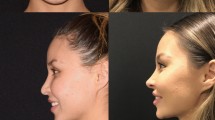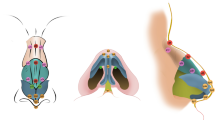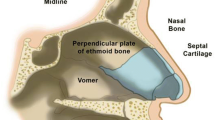Abstract
Background
Filler injections have been used in rhinoplasty to correct minor nose deformities and to augment the nasal dorsum. At the lower nose, the procedures are used to increase nasal tip projection and improve the bulbous nasal tip but they have never been used in the correction of the lateral crus weakness and collapsed external nasal valves.
Methods
The study was conducted with 14 human cadavers that underwent lower nose injection rhinoplasty using the columellar and alar injections as tripod augmentation. The nasal alae were tunneled and retrogradely injected by a needle. The compared parameters measured to evaluate the improvement before and after the treatment were basilar nasal width, interalar width, columella-nasal tip height, columellar-labial angle, and the length and width of the nostrils. Measurements were taken with a digital caliper. All measurements were matched and compared for statistical analysis.
Results
There were seven male and seven female Thai cadavers. Most of the values of the parameters were increased, but the basilar nasal width and interalar width were not changed. The columellar-labial angle, columella-nasal tip height, and nostril’s length showed statistically significant differences (P < .05), leading to positive changes in the nostril cross-sectional area, the nasal tip projection and the external nasal valve.
Conclusions
Injection rhinoplasty of the lower nose as tripod augmentation of the external nasal valve increases the nasal tip projection and the nostril cross-sectional area thus improving the functional and esthetic appearance.Level of Evidence: Not ratable.












Similar content being viewed by others
References
Nguyen AH, Bartlett EL, Kania K et al (2015) Simple implant augmentation rhinoplasty. Semin Plast Surg 29:247–254
Rohrich RJ, Ahmad J (2016) A practical approach to rhinoplasty. Plast Reconstr Surg 137:725e–746e
Han X, Hu J, Cheng L et al (2015) Multiplane hyaluronic acid (EME) in female Chinese rhinoplasty using blunt and sharp needle technique. J Plast Reconstr Aesthet Surg 68:1504–1509
Piggott JR, Yazdani A (2011) Hyaluronic acid used for the correction of nasal deviation in an 18-year-old Middle Eastern man. Can J Plast Surg 19:156–158
Tansatit T, Moon HJ, Rungsawang C et al (2016) Safe planes for injection rhinoplasty: a histological analysis of midline longitudinal sections of the Asian nose. Aesthet Plast Surg 40:236–244
Moon HJ (2016) Use of Fillers in rhinoplasty. Clin Plast Surg 43:307–317
Motamedi KK, Stephan SJ, Ries WR (2016) Innovations in nasal valve surgery. Curr Opin Otolaryngol Head Neck Surg 24:31–36
Berghaus A (2016) Modern rhinoplasty: is there a place for the closed approach? Facial Plast Surg 32:402–408
Barrett DM, Casanueva FJ, Cook TA (2016) Management of the nasal valve. Facial Plast Surg Clin North Am 24:219–234
Hahn S, Becker DG (2014) What are some tips and pearls for preserving and improving nasal function when performing a cosmetic rhinoplasty? Curr Opin Otolaryngol Head Neck Surg 22:58–62
Toriumi DM, Josen J, Weinberger M et al (1997) Use of alar batten grafts for correction of nasal valve collapse. Arch Otolaryngol Head Neck Surg 123:802–808
Silva Filho RO, Pochat VD (2016) Anatomical study of the lateral crural strut graft in rhinoplasty and its clinical application. Aesthet Surg J 36:877–883
Gubisch W, Eichhorn-Sens J (2009) Overresection of the lower lateral cartilages: a common conceptual mistake with functional and aesthetic consequences. Aesthetic Plast Surg 33:6–13
Pedroza F, Pedroza LF, Achiques MT et al (2014) The tripod graft: nasal tip cartilage reconstruction during revision rhinoplasty. JAMA Facial Plast Surg 16:93–101
Kim JH, Song JW, Park SW et al (2014) Tip extension suture: a new tool tailored for Asian rhinoplasty. Plast Reconstr Surg 134:907–916
Tasman AJ, Lohuis PJ (2012) Control of tip rotation. Facial Plast Surg 28:243–250
Manafi A, Barikbin B, Manafi A et al (2015) Nasal alar necrosis following hyaluronic acid injection into nasolabial folds: a case report. World J Plast Surg 4:74–78
Liew S, Scamp T, de Maio M et al (2016) Efficacy and safety of a hyaluronic acid filler to correct aesthetically detracting or deficient features of the Asian nose: a prospective, open-label, long-term study. Aesthet Surg J 36:760–772
Tanaka Y (2014) Oriental nose occidentalization and perinasal shaping by augmentation of the underdeveloped anterior nasal spine. Plast Reconstr Surg Glob Open 2:e197
Bryan ZT, Garrett AB, Lavigne K et al (2016) The wave flap: a single-stage, modified nasal sidewall rotation flap for the repair of defects involving the mid-alar groove. Dermatol Surg 42:176–182
Li S, Cao W, Cheng K et al (2006) Microvascular reconstruction of nasal ala using a reversed superficial temporal artery auricular flap. J Plast Reconstr Aesthet Surg 59:1300–1304
Ueda K, Shigemura Y, Hara M et al (2014) Skirt flap for nasal alar reconstruction. Plast Reconstr Surg Glob Open 2:e157
Zeikus PS, Maloney ME, Jellinek NJ (2006) Advancement flap for the reconstruction of nasal ala and lateral nasal tip defects. J Am Acad Dermatol 55:1032–1035
Signorini M, Liew S, Sundaram H et al (2016) Global aesthetics consensus: avoidance and management of complications from hyaluronic acid fillers-evidence- and opinion-based review and consensus recommendations. Plast Reconstr Surg 137:961e–971e
Beleznay K, Carruthers JD, Humphrey S et al (2015) Avoiding and treating blindness from fillers: a review of the world literature. Dermatol Surg 41:1097–1117
Hwang K, Lee GI, Park HJ (2015) Branches of the facial artery. J Craniofac Surg 26:1399–1402
Saban Y, Andretto Amodeo C, Bouaziz D et al (2012) Nasal arterial vasculature: medical and surgical applications. Arch Facial Plast Surg 14:429–436
Apostolou K, Niranjan NS (2016) Lateral nasal artery perforator V-Y flap for reconstruction of nasal defects. J Plast Reconstr Aesthet Surg 70:138–139
Kridel RW, Kwak ES, Watson JB (2016) Columellar aesthetics in open rhinoplasty. Facial Plast Surg 32:333–338
Mashiko T, Kinoshita K, Kanayama K et al (2015) Perpendicular strut injection of hyaluronic acid filler for deep wrinkles. Plast Reconstr Surg Glob Open 3:e567
Seok J, Hong JY, Choi SY et al (2016) A potential relationship between skin hydration and stamp-type microneedle intradermal hyaluronic acid injection in middle-aged male face. J Cosmet Dermatol 15:578–582
Halachmi S, Ben Amitai D, Lapidoth M (2013) Treatment of acne scars with hyaluronic acid: an improved approach. J Drugs Dermatol 12:e121–e123
Wollina U, Goldman A (2015) Fillers for the improvement in acne scars. Clin Cosmet Investig Dermatol 8:493–499
Author information
Authors and Affiliations
Corresponding author
Ethics declarations
Ethical approval
For this kind of study formal consent is not required.
Funding
None.
Conflict of interest
Tanvaa Tansatit, Prawit Apinuntrum, and Thavorn Phetudom declare that they have no conflict of interest.
Patient consent
Patients provided written consent for the use of their images.
Rights and permissions
About this article
Cite this article
Tansatit, T., Apinuntrum, P. & Phetudom, T. The cadaveric feasibility study of using filler augmentation at the lower nose for the reinforcement of the external nasal valve. Eur J Plast Surg 41, 119–128 (2018). https://doi.org/10.1007/s00238-017-1326-7
Received:
Accepted:
Published:
Issue Date:
DOI: https://doi.org/10.1007/s00238-017-1326-7




